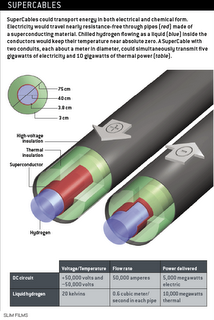A Power Grid for the Hydrogen Economy
Interesting new idea for distributing electricity without losses and hydrogen through a new power grid.
Ten years after the discovery of high-temperature superconductivity, a technical study by the Electric Power Research Institute (EPRI) concluded that with liquid nitrogen as a coolant, a five-gigawatt DC "electricity pipe" could compete economically with a gas pipeline or conventional overhead lines for transmission distances of 800 kilometers or more. Two of us (Grant and Starr) developed the idea further in papers that explored how ultracold hydrogen--either liquid or supercritical gas--might both chill the superconducting wires and deliver energy in chemical form within a continental-scale system.Such a grid would also help with intermittent energy from renewables like solar and wind, as the hydrogen in the lines could be used like a battery to store the energy.
The Super-Cable we have designed includes a pair of DC superconducting wires, one at plus 50,000 volts, the other at minus 50,000 volts, and both carrying 50,000 amps--a current far higher than any conventional wire could sustain. Such a cable could transmit about five gigawatts for several hundred kilometers at nearly zero resistance and line loss. (Today about a tenth of all electrical energy produced by power plants is lost during transmission.)
The Super-Grid could go a long way, too, toward removing one of the fundamental limitations to the large-scale use of inconstant energy from wind, tides, waves and sunlight. Renewable power plants could pump hydrogen onto the grid, rather than selling electricity. Alternatively, baseline generators could monitor the rise and fall in electrical output from these plants and might be able to use electrolysis to shift their electricity/hydricity blend to compensate.One issue I have always had with the hydrogen economy is that you lose lots of energy in creating the hydrogen. But, they claim that nuclear plants can create the hydrogen at the same efficiency as electricity.
For example, every 70-kilometer section of Super-Cable containing 40-centimeter-diameter pipes filled with liquid hydrogen would store 32 gigawatt-hours of energy. That is equivalent to the capacity of the Raccoon Mountain reservoir, the largest pumped hydroelectric facility in the U.S.
Next-generation nuclear plants can produce either electricity or hydrogen with almost equal thermal efficiency. So the operators of nuclear clusters could continually adjust the proportions of electricity and "hydricity" that they pump into the Super-Grid to keep up with the electricity demand while maintaining a flow of hydrogen sufficient to keep the wires superconducting.Overall sounds pretty good, so what is the catch?
The investment will undoubtedly be enormous: perhaps $1 trillion in today's dollars and in any case beyond the timescale attractive to private investment.Yikes! Some interesting ideas though, and maybe a limited version will prove to be economically feasible. Also, this image of the evolution of a supergrid gives you a good picture of what they see changing.
via Scientific American





No comments:
Post a Comment
Note: Only a member of this blog may post a comment.